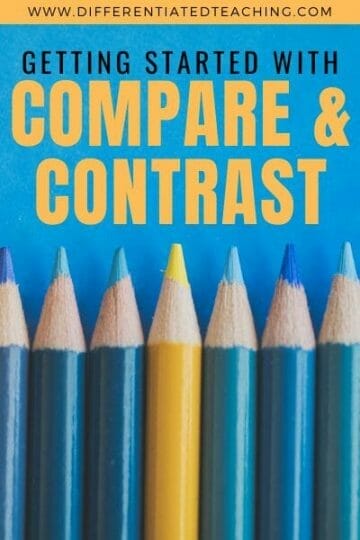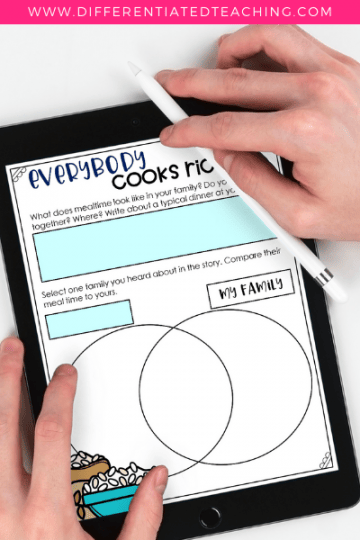How to effectively teach compare & contrast using a mentor text
Teaching compare and contrast is a great lesson for early in the school year because it is approachable for students and can be used in so many different ways. Comparative thinking is great for building connections between background knowledge and new concepts. It’s also great to incorporate into your explicit vocabulary instruction.
Venn diagrams are the most commonly seen graphic organizer for teaching this skill, and students must be taught how to use this tool to help them organize their thinking. Since they are also commonly included in state assessments, teaching students to use this type of organizer early in the school year can help ease the stress as testing approaches.

Today I want to share a great resource for teaching students how to use a Venn diagram to find similarities and differences between themselves and characters in a text.
While we often introduce this skill during a mini-lesson on character traits, it is also a great way to ease students into higher-level thinking skills. However, comparative thinking can be challenging for some students and others will be able to recognize it in a reading passage but will struggle to reproduce it in their writing. This is why modeling and pointing out the compare-contrast structure in a read-aloud is so important.
As you start to plan your lessons, there is lots to think about. To help you get started, I’ve included some great digital learning activities designed to facilitate effective instruction for these skills. You can find them at the end of this post.
Disclosure: I’ve included Amazon Affiliate links where applicable. These products won’t cost you any extra, but the earnings from the use of these links help support the maintenance of this site.
Why teach compare & contrast?
Humans are constantly examining the similarities and differences in life, but it is still important to explicitly teach them how to compare and contrast.
Teaching students how to compare and contrast using a graphic organizer is great for supporting higher level thinking skills. Since this is a skill often seen on standardized tests, these are skills students will use far beyond just reading. Science and social studies, for example, consistently involve having students be able to apply these skills to understand the world around them.
By explicitly teaching students to compare and contrast in reading, they’ll easily be able to access this skill in other contexts.
In addition, making connections by teaching compare and contrast to elementary students is a relatively easy task, making it great for the beginning of the school year.

How to incorporate other
Helping students make text-to-self connections by comparing and contrasting is an important foundational skill. Teaching students to look beyond just surface level comparisons can help them dig deeper into their reading and build understanding.
Whether this is your first year teaching reading or you’re looking for some new ideas to incorporate into your classroom, my hope is you’ll find some ideas and ready-to-use resources you can add to your lesson plans for this skill.
Before we dive into the lesson plan, here’s some background information on how this skill fits into the larger picture of teaching reading.
What standards address compare and contrast?
This skill is introduced in very different grade levels depending on what standards you use. This is a second grade standard in Texas, and students are expected to apply this skill to analyze character relationships by third grade, The Common Core standards introduce character analysis in third grade and expand upon it through the remaining elementary years.
Here are the Texas standards (TEKS) and Common Core State Standards (CCSS to aid with lesson plan documentation:
- TEKS 4.6E Make connections to personal experiences, ideas in other texts, and society
- TEKS Figure 19 Use a flexible range of metacognitive reading skills…to understand the author’s message
- CCSS R.1 Read closely to determine what text says explicitly and make logical inferences from it
What books are good for introducing & modeling comparing and contrasting?
There are so many great compare and contrast books to use with your lessons. While we tend to look at picture books as mentor texts, informational texts are great for teaching this skill.

Here are my 10 favorite books for teaching students to compare & contrast:
- The Pain & The Great One by Judy Blume
- Apples & Oranges: Going Bananas with Pairs by Sara Pinto
- Stellaluna by Janell Cannon
- Shark vs. Train by Chris Barton
- The Relatives Came by Cynthia Rylant
- Aaron and Alexander by Don Brown
- Who Would Win series
- What’s the Difference Between an Alligator & a Crocodile by Lisa Marie Bullard
- Poles Apart by Jeanne Willis
- Now and Ben by Gene Barretta
Before Reading: Introducing Compare & Contrast
Moving beyond the surface level can be hard for younger learners to grasp. While students can easily see external similarities and differences, it can be hard to dig deeper without prompting and support.
When introducing this skill to your students, it is important to begin by helping them define the terms and modeling the difference between a surface-level comparison and a deeper analysis.
Students need to be able to move beyond outward appearances when making connections. They must also move beyond what the author explicitly states in the text. Both of these skills require time and modeling to master successfully.

A great way to get started is by creating a Venn diagram comparing yourself to a student in your class. Have students take turns giving examples of physical attributes first. Then push students to move beyond these basic responses to identify similarities and differences that require more thoughtful analysis. When you finish, compare the two lists to help students internalize the differences between comparing and contrasting on a surface level and digging deep to think critically.
Here’s a great example of an anchor chart you may consider using with your class as you begin this foundational work.
Once you’ve done this as a group, you can have students break off into groups and complete an example using themselves or another classmate.
The positive about this approach is that it doesn’t require text. This means that your struggling readers get the chance to understand the skill without using up all their mental energy on decoding.
Transitioning to Text & Making Cross-Cultural Connections
Once your students have a solid grasp on how to compare and contrast two things are, you’re likely ready to transition them toward doing this using text.

At this point, I like to use Everybody Cooks Rice by Norah Dooley. As you read, have students pay attention to how each family’s mealtime looks. Also, discuss how each family cooks rice in a different way depending on where they are from.

After you finish reading, have students compare and contrast mealtime at home to one of the families in the story.
Give students a chance to share out how their family uses rice as a part of their meals. You’ll likely be surprised just how many different ways your class experiences rice as a meal staple.

Once students solidify this skill, you can transition them toward writing compare and contrast essays. However, they must master the foundations of comparing and contrasting first.
Here are a few ways you can offer some fun additional practice:
- Use free online games to practice the skill & keep students engaged
- Introduce t-charts to have students practice comparing and contrasting
- Consider using hula hoops to create a lifesize Venn diagram
Grab the free resources for teaching compare and contrast
Now that you’ve read about how you can get students to understand how to compare and contrast beyond just the surface level, I’m sure you’re ready to tackle this in your classroom.
That’s why I created a set of free resources for teaching this skill. In this free digital practice pack, you’ll find:
- Digital Read Aloud for Everybody Cooks Rice by Norah Dooley
- Interactive Everybody Cooks Rice Digital Story Organizer
- Venn diagram digital graphic organizer
Sign up to access these great freebies and enter your name to win a set of diverse mentor texts that are perfect for teaching reading skills inclusively this year.
Get the freebies:






